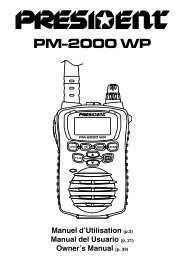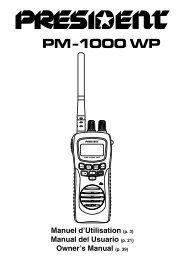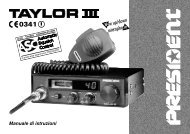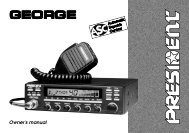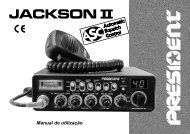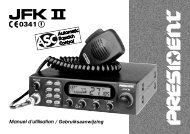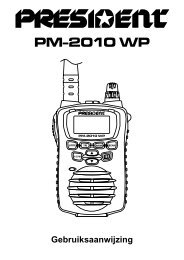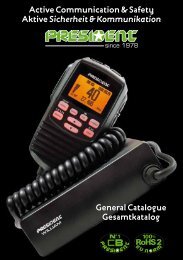Handbuch / Owner's manual - President Electronics
Handbuch / Owner's manual - President Electronics
Handbuch / Owner's manual - President Electronics
Sie wollen auch ein ePaper? Erhöhen Sie die Reichweite Ihrer Titel.
YUMPU macht aus Druck-PDFs automatisch weboptimierte ePaper, die Google liebt.
English<br />
2) ANTENNA INSTALLATION<br />
a) Choosing your antenna:<br />
- For CB radios, the longer the antenna, the better its results. Your dealer will be able<br />
to help you with your choice of antenna.<br />
b) Mobile antenna:<br />
- Must be fixed to the vehicle where there is a maximum of metallic surface (ground<br />
plane), away from windscreen mountings.<br />
- If you already have a radio-telephone antenna installed, the CB antenna should be<br />
higher than this.<br />
- There are two types of antenna: pre-regulated which should be used on a good<br />
ground plane (e.g. car roof or lid of the boot), and adjustable which offer a much<br />
larger range and can be used on a smaller ground plane (see § 5, Adjustment of<br />
SWR).<br />
- For an antenna which must be fixed by drilling, you will need a good contact between<br />
the antenna and the ground plane. To obtain this, you should lightly scratch<br />
the surface where the screw and tightening star are to be placed.<br />
- Be careful not to pinch or flatten the coaxial cable (as this runs the risk of break down<br />
and/or short circuiting).<br />
- Connect the antenna (B).<br />
c) Fixed antenna:<br />
- A fixed antenna should be installed in a clear a space as possible. If it is fixed to a<br />
mast, it will perhaps be necessary to stay it,<br />
according to the laws in force (you should<br />
seek professional advice). All PRESIDENT<br />
antennas and accessories are designed<br />
to give maximum efficiency to each CB<br />
radio within the range.<br />
3) POWER CONNECTION<br />
Your PRESIDENT HARRY III ASC is protected against an inversion of polarities. However,<br />
before switching it on, you are advised to check all the connections. Your equipment<br />
must be supplied with a continued current of 12 volts (A). Today, most cars and lorries<br />
are negative earth. You can check this by making sure that the negative terminal<br />
of the battery is connected either to the engine block or to the chassis. If this is not<br />
the case, you should consult your dealer.<br />
WARNING: Lorries generally have two batteries and an electrical installation of 24<br />
volts, in which case it will be necessary to insert a 24/12 volt converter (type CV 24/12<br />
PRESIDENT) into the electrical circuit. The following connection steps should be carried<br />
out with the power cable disconnected from the set.<br />
a) Check that the battery is of 12 volts.<br />
b) Locate the positive and negative terminals of the battery (+ is red and - is black).<br />
Should it be necessary to lengthen the power cable, you should use the same or a<br />
superior type of cable.<br />
c) It is necessary to connect your CB to a permanent (+) and (-). We advise you to connect<br />
the power cable directly to the battery (as the connection of the CB cable to<br />
the wiring of the car-radio or other parts of the electrical circuit may, in some cases,<br />
increase the likelihood of interference).<br />
d) Connect the red wire (+) to the positive terminal of the battery and the black (-)<br />
wire to the negative terminal of<br />
the battery.<br />
e) Connect the power cable to your<br />
CB radio.<br />
WARNING: Never replace the<br />
original fuse (2 A) by one of a<br />
different value.<br />
OUTPUT RADIUS PATTERN<br />
18



